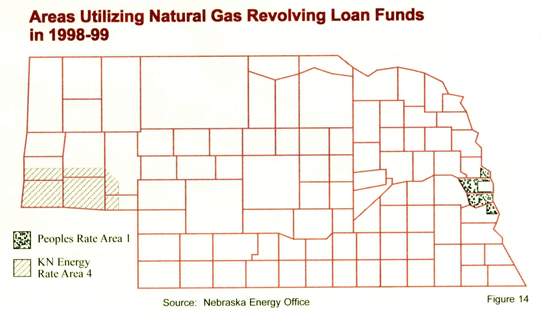
Natural Gas Technical Assistance
About 30 percent of the state's natural gas consumers receive their service from one of 15 municipally-owned natural gas utilities. Two towns, Schuyler and Neligh, are in the process of taking over control of their natural gas system.
The remaining 70 percent receive natural gas from one of four investor-owned natural gas utilities - KN Energy, Midwest Gas, Northwestern Public Service and Peoples Natural Gas Company.
One town in Nebraska may be unique. Kearney has granted franchises to two different investor-owned natural gas utilities to provide service to the town's residents.
Natural gas is imported into the state to the investor-owned and municipally-owned utilities primarily through major pipelines operated by Northern Natural Gas Company and KN Energy.
Beginning in 1998, an increasing number of smaller natural gas customers have been able to select other companies to meet their natural gas needs. However, the traditional retail gas company still delivers the natural gas to the customer.
At this time, not all consumers in the state can choose their gas supplier. However, the Legislature plans to begin a study of the state's natural gas system and relevant regulation in light of changes at the national regulatory level.
Municipal Natural Gas Regulation Act
Nebraska is one of only two states in the nation to regulate investor-owned natural gas suppliers at the local level. Village boards and city councils review rate requests under the state's Municipal Natural Gas Regulation Act. The Energy Office administers the Municipal Natural Gas Regulation Revolving Loan Fund, created by the Act to provide interim financing of rate regulation.
Revolving Loan Fund
The Municipal Natural Gas Regulation Revolving Loan Fund was initially capitalized with $350,000 in oil and natural gas severance tax revenues. The fund finances local review of utility-initiated general rate requests and judicial review, if necessary. Groups of communities borrow from the fund to finance the rate studies and the fund is replenished in the same amount by the utilities, which in turn recover the cost of regulation from the ratepayers.
Regulations governing the loan fund were adopted and took effect in 1987.
1998-1999 Loan Fund Activities
 |
Three loans were repaid during the reporting period as well:
Throughout the reporting period, the Energy Office provided assistance to municipal officials during all phases of the regulatory process as mandated by statute.
Typical kinds of assistance include organizing and providing support services for rate area committees, publishing periodic issues of the Natural Gas Rate Regulation Update in each utility's service area, issuing requests for proposals for professional services, providing regulatory timelines, informational broadcasts and responding to specific inquiries regarding the regulatory process.